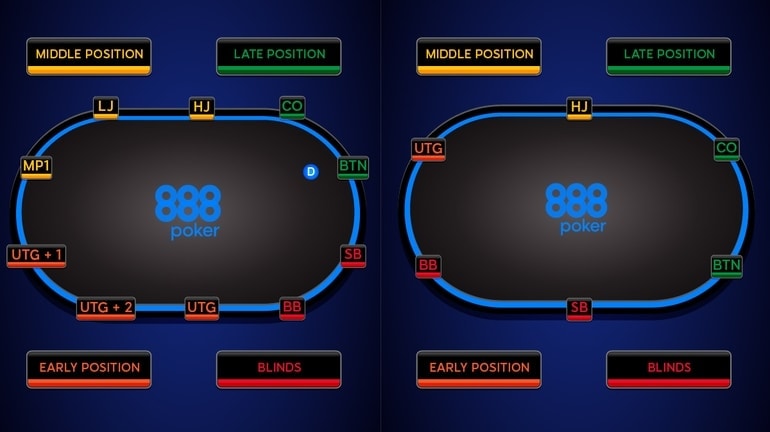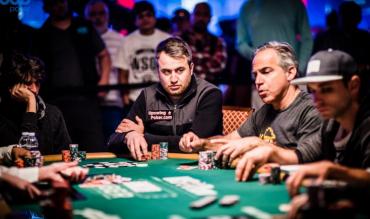It’s extremely common to hear poker players talk about the importance of ‘position’ in poker.
What exactly is position, and why is it so important?
It’s normal for new players to assume that poker is a game based entirely around the cards we hold. However, this assumption is not correct – the situation can often be more important than the cards.
Strong hands can sometimes be problematic in the wrong scenario, while relatively weak holdings may end up being decently profitable.
Position plays a crucial role in this.
We will discuss the following -
What Is Position in Poker?
When poker players use the term “position”, they are not always referring to the same aspect of the game.
For example, the seats at a poker table are given unique names based on their position relative to the dealer button. The term “position” could be used to describe the exact seat a player at the table occupies.
Most commonly, however, discussions regarding position are to do with who acts last in each betting round.
If a player acts last, he is said to be “in position”.
Who has Position?
In Position (IP) – This player acts last on every betting round.
Out of Position (OOP) – This player acts first on every betting round
This fact is very crucial since the IP (in position) player is considered to have a distinct advantage over his OOP (out of position) opponent. Strategically, a good player will look to increase the number of hands he plays IP while limiting the number of hands he plays OOP.
Acting last in every postflop betting round is referred to as having absolute position.
Depending on the flow of action, a player with absolute position may sometimes find himself not acting last on a given betting round.
We can express this concept by saying that such a player lacks relative position. More on this later.
In Position vs Out of Position
So, why exactly does an IP player have an advantage over his OOP opponent? One reason is based around the flow of information. Poker is essentially a game of information – the player with the most data can make the best decisions (if we assume an equivalent skill level). The IP player simply has more info than his OOP opponent.
Other reasons why position is valuable involve controlling the pot size and extracting maximum value with strong hands.
Let’s see these reasons broken down:
Advantage #1 – The IP player gets to see what his opponent does first on each street before needing to act. The OOP player must act in the dark.
When IP, we get a hint regarding our opponent’s hand strength. Does he bet or check? If he bets, which sizing does he use? If he checks or bets small, he is most likely to be weak on average. If he bets large, this is an indicator he might be strong. As the IP player, we can adjust our response accordingly.
The OOP player, on the other hand, has no clue regarding our hand strength. If only he knew whether we planned to bet or check, he’d be able to make a more informed decision.
His decisions will be less informed than his IP opponents over the long run.
Advantage #2- The IP player can control the size of the pot and flow of the action more easily.
Since the IP player often has the final say on each street, he is ultimately the one who decides whether the pot 1) stays the same size or 2) grows larger.
Imagine the following flop scenario:
Pot 6bb.
OOP bets 4bb.
IP?
The player IP now has a choice. If he likes the size of the current pot, he can simply call and progress to the next street. If he prefers a larger pot, he can elect to raise.
Now let’s think about it from the OOP player’s perspective.
Pot 6bb.
OOP?
If OOP prefers a small pot, he might elect to check. Unfortunately, we don’t progress to the next street after checking. If IP doesn’t like the size of the pot, he can still increase it by making a large bet in position. If OOP prefers a large pot, he can bet, but his IP opponent retains the ability just to call (limiting the size of the pot).

Of course, OOP could attempt to go for a check/raise, but he has no idea whether his opponent will bet or not. If he checks back, the check/raise opportunity is lost.
This factor is not to say that OOP is entirely helpless. If IP bets, it is now OOP who decides whether just to call and proceed to the next street or raise and increase the size of the pot. This scenario is an example of relative position which will be discussed later.
Advantage #3 – It’s easier to extract value when IP
In truth, all three of these advantages share commonalities, but let’s explore the power of position in a slightly different context.
Example – We river the nuts after check/calling the turn. How do we extract the most value on the river?
The OOP player has a little bit a problem here. Should we donk-lead the river or simply check and hope that our opponent continues his aggression on the river. Both plans have significant holes.
Donk Bet – The advantage is that we potentially get called by some of our opponent’s mid-strength hands that he was looking to check back with. The disadvantage is that we have now denied our opponent the opportunity to bluff. Perhaps he was planning on firing a huge river bullet with air, but now we have missed that extra value.
Check–The advantage here is that our opponent can bluff his air hands and that we might even be able to get a check/raise through, increasing the size of the pot even further. The severe disadvantage, though, is that our opponent may simply check back, leaving us with no payout at all.
Example – We river the nuts after calling the turn IP. How do we extract the most value on the river?
Suddenly our gameplan has now switched from problematic to super straightforward since we get to see what our OOP opponent does before us. If he bets, we’ll obviously raise. If he checks, we’ll obviously bet. Having position allows us to play the hand perfectly and extract the maximum value with our strong hand.
Absolute vs Relative Position
If we are familiar with popular poker games such as No-Limit Hold’em and Pot-Limit Omaha, we’ll know that OOP players sometimes get to act last in both preflop and postflop scenarios.
For example, two players are in the pot, the BB (bigblind) and the BTN (button). Although BTN gets to act last on every postflop betting round, it was actually the bigblind who got to act last on the preflop betting round. So why is this the case?
Although the BTN has absolute position,the BB has relative position on the preflop betting round. BB got to act last temporarily due to the flow of action. BB technically acted before BTN preflop because he posted the mandatory big-blind payment.
However, as a result, the BB is now entitled to act again in the preflop betting round after the BTN has acted. So, although the BB is technically OOP, he has temporarily gained relative position due to his mandatory BB post.
If this concept is confusing, it can generally be cleared up with a simple postflop example, similar to one we have already looked at.
Pot 6bb.
OOP bets 4bb.
IP Raises to 12bb.
Here we see two players heads up to the flop. The OOP player bets, and the IP player raises. If OOP were just to call the raise, we’d proceed to the turn. So, who really got act last on that flop betting round? The OOP player, of course. After the IP player raises, the OOP player is temporarily granted relative position. If the OOP player were to re-raise,then the relative position would switch back to the IP player.
The importance of relative position becomes even more apparent when considering multi-way scenarios.
Let’s take players A, B, and C, where A is OOP, C is IP, and B is in the middle:
Pot 10bb.
Player A leads for 5bb.
Player B raises to 15bb.
Player C?
Player C has to be careful here. Although he has absolute position, he no longer has relative position. Due to Player B’s raise, Player A now has relative position. If Player C calls, Player B’s raise, he has to consider the possibility of Player A re-raising behind. Player C’s calling range has to tighten as a result of the fact that he no longer has relative position.
On the other hand, if Player B were simply to call Player A’s 5bb lead, Player C would retain both absolute and relative position (not that absolute position can ever be lost).
Positions at the Poker Table
As discussed at the outset, each position at the poker table has a unique name which is a function of that seat’s location relative to the BTN.

In the images, we see an example of a 6-max short-handed (SH) poker table and a full-ring (10 or 9-handed FR) table. The first 6 positions are roughly identical although they may receive different names depending on whether the game is SH or FR.
Here is a brief description of the positions:
Big Blind (BB) – This position is forced to place the mandatory 1bb preflop payment although it is granted relative position in return. Despite typically being OOP postflop, wide cold-calling ranges are often incentivised due to the effective discount on the preflop call (1bb already invested) and the advantages of relative position.
Small Blind (SB) – This position is forced to make a mandatory blind payment preflop (usually 0.5bb) and will always be out of position postflop. (At least BB may sometimes have position on SB). SB does not even gain relative position in exchange for the blind payment, being forced to act before BB preflop. Therefore, it’s recommended to play significantly tighter from the SB than from the BB.
Button (BTN) – The BTN is considered the best position at the table. The BTN is always guaranteed to have absolute position postflop. The relative position preflop is also pretty reasonable, with only the blinds acting after the BTN preflop.
Cut-Off (CO) – This position is somewhat inferior to the BTN. Although the CO will have position against the blinds and the earlier positions, it will be OOP when getting action from the BTN. This situation is also not an unlikely occurrence since the BTN will often be looking to play pots against the CO and utilise its positional advantage.
Middle Position (MP) / Hijack (HJ) – The name of this position will depend on whether the table is SH or FR. At a short-handed table, it is referred to as ‘middle-position’, while on a FR table it is called the ‘Hijack’. There are several middle positions on a FR table, but only one middle position on a SH table. This seat will be IP against the blinds and earlier positions, but OOP if getting action from the BTN or CO. Tight ranges are typically incentivised from this seat.
Under-the-Gun (UTG) / Lojack (LJ) – The term ‘Under the Gun’ always refers to the first player to act preflop (excluding mandatory blind payments). The designation UTG only applies to SH tables in this scenario. In FR games, this spot is referred to as the ‘Lojack’. As we progress to earlier and earlier positions, the chances of being OOP postflop increase dramatically. Earlier positions are inferior and require stronger starting hands to play profitably.
Middle Position (MP1) – This seat only exists on a FR table and refers to the seat just to the right of the Lojack. The term “middle position” may also be used to encompass any of the MP1, Lojack and Hijack positions in the context of a FR table.
Under-The-Gun (UTG, UTG+1, UTG+2) – The designation ‘UTG’ only applies to the first seat at the table to act preflop. The other early positions are given descriptions based on their position relative to UTG, i.e. UTG+1, UTG+2 etc. At a 9-handed table (as opposed to 10-handed), there would be UTG, UTG+1, but no UTG+2.
Putting it Together
It’s always crucial to establish whether we are IP or OOP postflop and figure out the effects it will have on our strategy. However, it’s good to take things one step further and consider how likely it is that our preflop position results in an IP or OOP postflop scenario and construct our preflop ranges accordingly.
Finally, we should be able to follow the flow of the action carefully and establish which player has relative position at any given moment.
Understanding position is often more important than the actual cards we are dealt.


